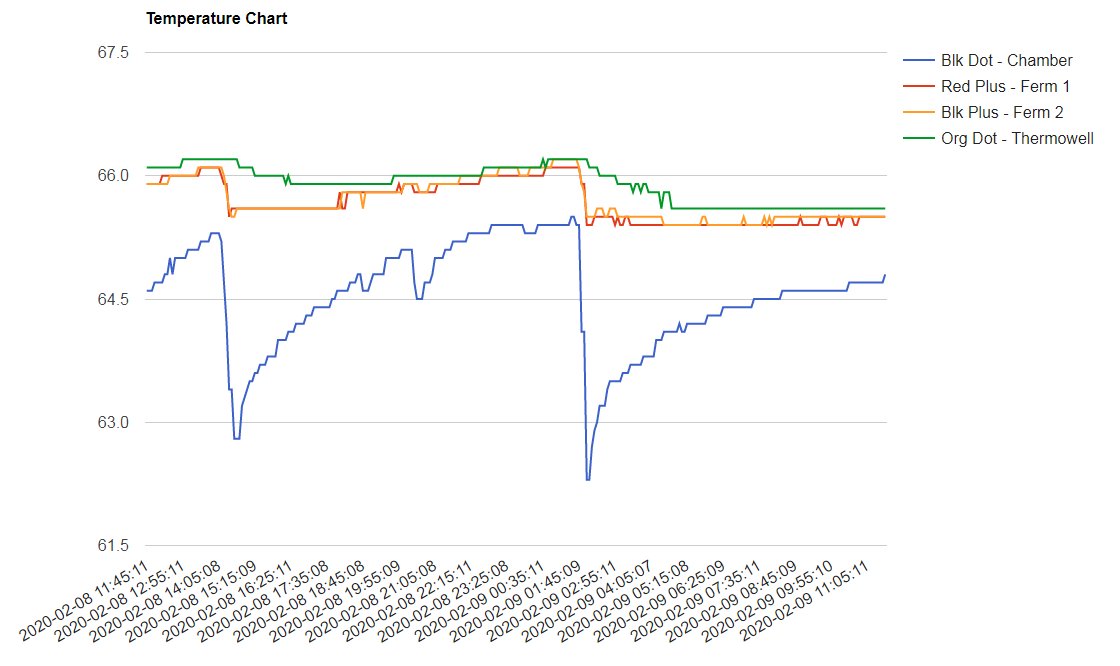nathanscrivener
Active Member
- Joined
- May 24, 2020
- Messages
- 36
- Reaction score
- 17
This may be somewhat yeast dependent, so I'm not talking about kveik for example here.
I started out making extract beer on a WilliamsWarn brewmaster, which is essentially a glycol jacketed stainless unitank. It was capable of maintaining fermentation temperature to quite a high degree of precision. Recently I sold that that and decided to go the brew in a keg in a temperature controlled fridge way, as I figured I had unnecessary capital tied up in the brewmaster and could achieve the same result with cheaper equipment.
The first brew I just placed the temperature probe for the temperature controller in my fridge and let it work on ambient temperature. I found that there was a fair bit more variability in the beer temperature (measured by my Tilt hydrometer), up to 3c warmer than the ambient. (I think that's about 5f). Despite this, the beer (a pilsner) turned out great. One of my best yet in fact.
With my current brew I've strapped the thermometer probe to the side of the keg and put some bubble wrap over it for insulation. This is now able to keep it within 0.5 degrees C even during high krausen. Whatever variation is occurring is within the margin of error of the Tilt.
I've also built a DIY brewpi controller which promises even more accurate control, down to 0.1 degree accuracy. Haven't tried it yet because it requires installing a thermowell in my kegs.
All of this has got me wondering, what level of precision is necessary before any further improvements are not going to make a difference in the quality of the finished beer? My best guess is that there MIGHT be some difference in SOME fermentations between ambient and 'strapped to the side' level of control. But anything more than that is unlikely to provide any further benefit to the beer. Which would make the brewpi a bit of a waste of time (although the ability to track and control via a web interface is nice).
Thoughts?
I started out making extract beer on a WilliamsWarn brewmaster, which is essentially a glycol jacketed stainless unitank. It was capable of maintaining fermentation temperature to quite a high degree of precision. Recently I sold that that and decided to go the brew in a keg in a temperature controlled fridge way, as I figured I had unnecessary capital tied up in the brewmaster and could achieve the same result with cheaper equipment.
The first brew I just placed the temperature probe for the temperature controller in my fridge and let it work on ambient temperature. I found that there was a fair bit more variability in the beer temperature (measured by my Tilt hydrometer), up to 3c warmer than the ambient. (I think that's about 5f). Despite this, the beer (a pilsner) turned out great. One of my best yet in fact.
With my current brew I've strapped the thermometer probe to the side of the keg and put some bubble wrap over it for insulation. This is now able to keep it within 0.5 degrees C even during high krausen. Whatever variation is occurring is within the margin of error of the Tilt.
I've also built a DIY brewpi controller which promises even more accurate control, down to 0.1 degree accuracy. Haven't tried it yet because it requires installing a thermowell in my kegs.
All of this has got me wondering, what level of precision is necessary before any further improvements are not going to make a difference in the quality of the finished beer? My best guess is that there MIGHT be some difference in SOME fermentations between ambient and 'strapped to the side' level of control. But anything more than that is unlikely to provide any further benefit to the beer. Which would make the brewpi a bit of a waste of time (although the ability to track and control via a web interface is nice).
Thoughts?
























![Craft A Brew - Safale S-04 Dry Yeast - Fermentis - English Ale Dry Yeast - For English and American Ales and Hard Apple Ciders - Ingredients for Home Brewing - Beer Making Supplies - [1 Pack]](https://m.media-amazon.com/images/I/41fVGNh6JfL._SL500_.jpg)
























